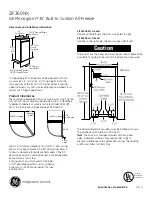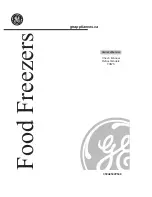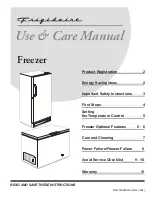
NOTE: The thermostat bulb for the refrigerator is em-
bedded in the coil, top center location.
Begin by removing the evaporator cover as outlined
in section
“
V a.
”
Next, remove the screws that secure
the thermostat and then disconnect the lead wires from
the thermostat (see figure 5).
Remove the thermostat bulb from its location (see fig-
ure 7).
Reverse the procedure to install.
V. REMOVAL & REPLACEMENT OF PARTS (cont
’
d)
WARNING: UNPLUG UNIT BEFORE SERVICING
27
”
Models
48
”
& 60
”
Models
V. c - THERMOSTAT:
NOTE: The thermostat bulb for the refrigerator is above
the evaporator coil, front area location, access from
the left side of the evaporator coil, behind the door
mullion.
Begin by removing the evaporator cover as outlined
in section
“
V a.
”
Next, remove the screws that secure
the thermostat and then remove the lead wire from the
thermostat (see figure 6).
Remove the thermostat bulb from the mounting clips
on the evaporator coil (see figure 8).
Reverse the procedure to install.
-6-
-17-
VI. SERVICE PROCEDURES & ADJUSTMENTS (cont
’
d)
WARNING: CERTAIN PROCEDURES IN THIS SECTION REQUIRE ELECTRICAL TEST OR MEASUREMENTS WHILE
POWER IS APPLIED TO THE MACHINE. EXERCISE EXTREME CAUTION AT ALL TIMES. IF TEST POINTS ARE
NOT EASILY ACCESSIBLE, DISCONNECT POWER, ATTACH TEST EQUIPMENT AND REAPPLY POWER TO TEST.
VI. e - EVACUATING SYSTEM/GUIDELINES (cont
’
d):
•
Blow down of system with DRY NITROGEN prior to
evacuation is acceptable and many times desirable.
See”System Clean-Up.”
•
Evacuate to 200 microns.
PROCEDURE
WARNING: DISCONNECT THE ELECTRICAL POWER
TO THE MACHINE AT THE MAIN CIRCUIT BOX. PLACE
A TAG ON THE CIRCUIT BOX INDICATING THE CIR-
CUIT IS BEING SERVICED.
WARNING: THIS PROCEDURE REQUIRES THE USE OF
REFRIGERANTS. BE CERTAIN THE WORK AREA IS
WELL VENTILATED. SAFETY GOGGLES AND
GLOVES SHALL BE WORN SINCE REFRIGERANTS
MAY CAUSE BURNS TO THE SKIN.
1) Access the refrigeration system as outlined under
“SYSTEM ACCESS.”
2) Connect low (blue) side of gauge manifold to
schrader valve on compressor process line and high
(red) side of gauge manifold to schrader valve on fil-
ter/drier process line.
3) Connect center line of gauge manifold to vacuum
pump.
4) Turn vacuum pump on and open both sides of gauge
manifold.
5) Pull a vacuum to 200 microns.
6) Break the vacuum with 3 psig of dry nitrogen.
7) Repeat steps 5 and 6.
8) Pull vacuum to 200 microns.
9) Charge system and check for proper operation.
VI. f - CHARGING SYSTEM:
WARNING: DISCONNECT THE ELECTRICAL POWER
TO THE MACHINE AT THE MAIN CIRCUIT BOX. PLACE
A TAG ON THE CIRCUIT BOX INDICATING THE CIR-
CUIT IS BEING SERVICED.
WARNING: THIS PROCEDURE REQUIRES THE USE OF
REFRIGERANTS. BE CERTAIN THE WORK AREA IS
WELL VENTILATED. SAFETY GOGGLES AND
GLOVES SHALL BE WORN SINCE REFRIGERANTS
MAY CAUSE BURNS TO THE SKIN.
1) Access the refrigeration system.
2) Attach gauge manifold set to the system, low side
to process tube on the compressor and the high side
to the process tube on the drier.
NOTE: See
“
SYSTEM ACCESS.
”
VI. f - CHARGING SYSTEM (cont
’
d):
3) Be sure system is properly leak checked and evacu-
ated before charging as outlined under
“
LEAK
CHECK
”
and
“
EVACUATING SYSTEM.
”
4) Make certain both valves are closed on the gauge
manifold. Open the valve on the bottle. Bleed charg-
ing hose at the manifold gauge to remove the air.
NOTE: Initially charge system through high side to
prevent liquid refrigerant from reaching compressor.
5) Open the high side gauge valve (red). Allow refrig-
erant to flow into the system until the nameplate charge
is reached or until the high side will not accept any
more refrigerant. At this point, shut the gauge and
bottle valves.
6) Reconnect power to the unit and check for proper
operation and high pressure leaks.
7) Add the remaining amount of refrigeration charge
through the low side with the compressor running.
8) Check for proper operation and leaks.
9) Disconnect power to the unit and replace any cov-
ers removed.
VI. g - SYSTEM CLEAN UP/INTRODUCTION:
When a compressor burn-out or moisture infiltration
is encountered, the service person must make the
determination as to the degree of system contamina-
tion. Normally a compressor burn-out will fit into one
of three catagories:
•
CONTAINED - compressor oil not acidic, no oil dis
coloration.
•
CONTAMINATED COMPRESSOR - oil acidic,
discoloration of oil, contamination limited to
compressor.
•
MASSIVE CONTAMINATION - contaminated oil
and/or refrigerant pumped through system.
CONTAINED
1) Replacement of liquid line drier.
2) Install suction filter drier for clean up and then re-
move it when service is complete. Usually within 48
hours.
3) Replacement of compressor.
4) Evacuation (to 200 microns).
5) Charge by weight.
CONTAMINATED COMPRESSOR
The “contaminated compressor”requires the same
procedure as the
“
contained
”
burn-out. Plus, the sys-
tem must be flushed with nitrogen after the compres-
sor and drier has been removed.








































